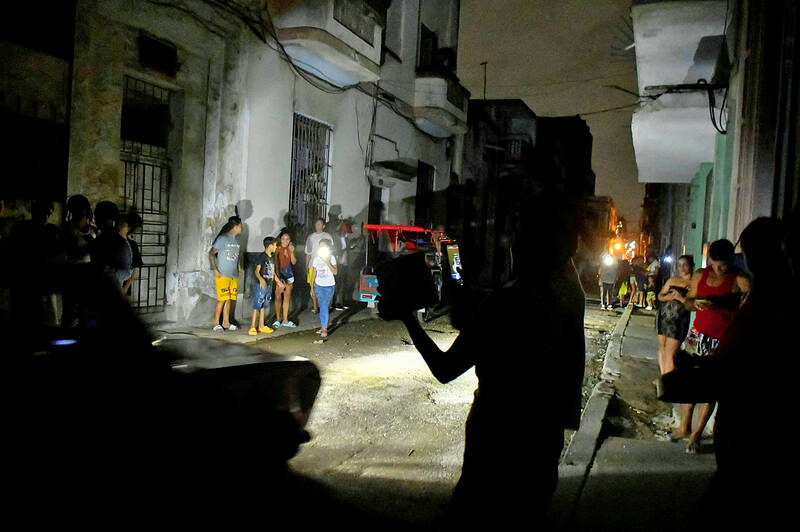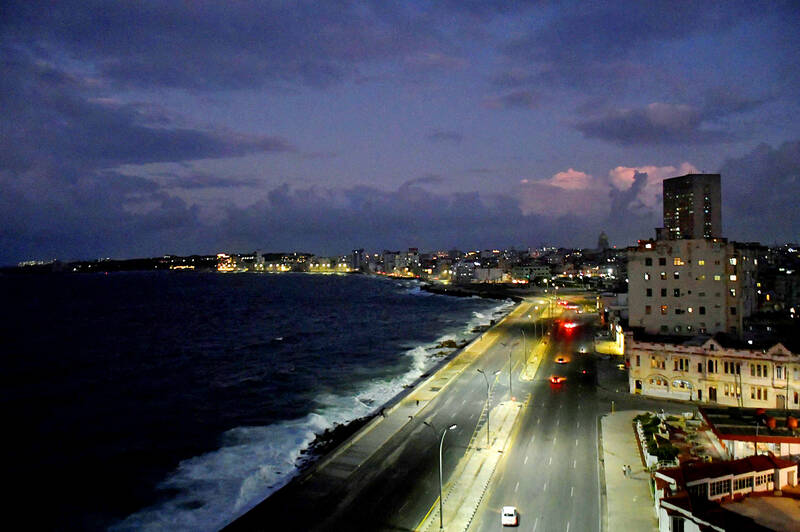HAVANA: Repeated blackouts have left residents of the Cuban capital concerned about food, water supply and the nation’s future, but so far, there have been few protests
The Guardian, Havana
Maria Elena Cardenas, 76, lives in a municipal shelter on Amargura Street in Havana’s colonial old town.
The building has an elegant past, but for the last few days Maria has been cooking with sticks she had found on the street.
“You know, we Cubans manage the best we can,” she said.

People gather during a protest as their street remained without electricity due to a blackout, which began on Oct. 18 and affected swaths of the Caribbean island, in Havana on Monday last week.
Photo: REUTERS
She lives in the shelter because her home collapsed, a regular occurrence in the poorest, oldest parts of the beautiful city.
Cuba’s government has spent the last days attempting to get the island’s national grid functioning after repeated island-wide blackouts. Without power, sleep becomes difficult in the heat, food spoils and the water supply fails.
Parts of Cuba’s communist system still function: the municipality sent Maria food. “We are three families here,” she said. “I live alone, the lady who lives next to me [does] also, and there are two children, the children’s mother, her aunt and an elderly man.”

Cars drive on Havana’s seafront Malecon Boulevard on Monday last week.
Photo: Reuters
A week after the blackout, the island has returned to the status quo ante with regular power cuts of up to 20 hours a day, but the crisis has left a deep, melancholy dread about the future.
This crisis began on Oct. 17, when an order went out for all non-essential state workers to go home.
The effort to save power did not save the system, and a day later, the island went dark. Antonio Guiteras, one of the main power stations, shut down, crashing all the other big generating stations in the system.
“It’s very hard to restart a power station,” said a retired engineer from Antonio Guiteras, who asked to remain anonymous. “You need to produce a lot of electricity just to get it going.”
Antonio Guiteras was built in 1989, and is now battered and obsolete. “The truth is that it was built rotten,” the engineer said. He told harrowing stories of working with faulty safety equipment, political management who would disappear when problems arose and a system long pushed to its limit.
The government acknowledges the parlous state of its system, blaming the 62-year old-trade embargo imposed by the US.
“Financial and energy persecution” made it difficult to “import fuel and other resources necessary,” Cuban President Miguel Diaz-Canel said.
For most of its existence, Cuba’s government has relied on the largesse of allies — first the Soviet Union, then Russia and Venezuela.
However, those countries, facing their own difficulties, have cut supplies heavily. “It’s like trying to keep a sinking ship afloat with corks,” one European diplomat said.
In a televised address, Cuban Prime Minister Manuel Marrero said the emerging private sector would have to pay more for its power, while the government looks to renewables to secure its energy needs.
The island has a lot of sunshine, but the multiple attempts to start solar projects have nearly all failed when the companies involved failed to get paid.
Instead, a deal has been cut with a Chinese firm to provide the materials for a slew of solar farms in return for access to Cuba’s nickel deposits, but with more than 10 percent of Cuba’s population having fled the economic crisis on the island in the past two years, there is skepticism whether the expertise remains to build such systems.
US President Joe Biden has said that while he is “tough” on the Cuban government, he supports the Cuban people.
However, Washington could do much more to help Cuba, said US academic William LeoGrande in the latest issue of Foreign Policy magazine.
“The proponents of regime change should be careful what they wish for,” he wrote. “A collapse of the regime would be a humanitarian disaster, spurring an emigration tsunami far larger than what we have seen so far.”
Unlike during previous power cuts, there has been very little protest this time, beyond the bashing of some pots and pans. People seem exhausted and government ministers have made it clear that the government would come down hard on any “indecent” behavior.
Dariel Ramirez was sitting on his stoop in the old town. He did not have much to eat because he had shared his stored food with others before it spoiled.
Asked how he was preparing for any repeat of the power crisis, he pointed toward the Museum of the Revolution, where the central symbol of communist rule is displayed: the boat on which revolutionaries and former Cuban presidents Fidel and Raul Castro arrived from Mexico in 1956.
“If this happens again, we need to prepare the Granma yacht,” he said. “So we can all sail away.”



